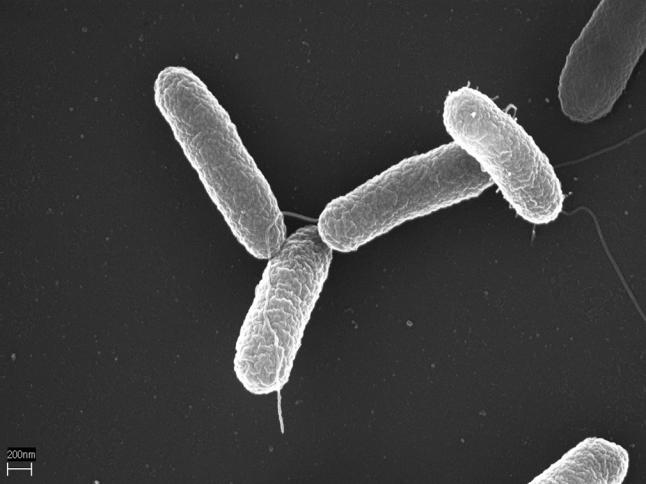Playlist
Show Playlist
Hide Playlist
Salmonella – Enteric Bacteria
-
Slides 03 EntericBacterialDiseases MicrobiologyAdvanced.pdf
-
Download Lecture Overview
00:01 Now let's move to salmonella. 00:03 These are another strain of enteric bacteria that cause focal infection of the vascular endothelium. May cause bloody diarrhea, as do some of the E coli strains. 00:15 These bacteria infect not just the gut, but a variety of other organs as well. 00:20 They can infect the bones. 00:21 For example, in patients with sickle cell disease causing osteomyelitis. 00:27 Infections with salmonella are associated with nausea, vomiting and diarrhea, and then another consequence with different strains is called typhoid fever, in which we have systematic spread of the bacteria. 00:43 These salmonella strains are common members of the microbiome of many animals, for example chickens, cows, and reptiles. 00:53 Pet turtles often have these strains of salmonella in them. 00:58 The turtles are fine. In fact, all of these animals are not affected by their presence. 01:01 But there have been outbreaks of salmonella disease in children caused by contamination from pet turtles. You buy a pet turtle at a pet shop, you bring it home and you have a salmonella infection. 01:13 Eggs are often contaminated with salmonella, and there have been foodborne outbreaks of infection from egg products. 01:22 Typhoid fever, another manifestation of salmonella infection, is often transmitted from a human carrier. 01:31 This can involve transmission via food or water. 01:34 A very famous example of this kind of infection, typhoid fever, is Typhoid Mary. 01:41 She was a carrier of the bacterium. 01:44 She was not sick, and she was involved in food preparation and infected many, many people until it was discovered that she was the source of the infection. 01:54 So Typhoid Mary lived many years ago, and the solution was to put her away in a room and not let her interact with anyone. 02:03 Which is not really satisfactory, of course, but now we understand what's happening, and we can take other measures to minimize transmission from these carrier individuals who still exist. 02:15 So, as you might guess, these infections are acquired by fecal-oral contamination. 02:20 In the case of Typhoid Mary, for example, the bacteria, she's excreting them. 02:25 If she doesn't have good hand hygiene, she's going to contaminate food preparation. 02:30 The bacteria make their way to the intestine. 02:33 They penetrate the mucosal barrier. 02:35 They enter M cells as well as epithelial cells, and they're carried through to the underlying tissues by endocytosis, by endocytic processes. 02:47 Bacteria make their way to the lamina propria, which is again that space underlying the epithelial sheet. 02:53 In the process, sodium chloride is imbalances, is introduced so that diarrhea results and the bacteria then spread from the underlying spaces to the bloodstream. 03:05 So this is not something that we see with the watery diarrhea strains, the spread from the initial site of infection. 03:11 They're confined. But these salmonella strains can spread typically from the lamina propria. The bacteria enter mesenteric lymph nodes and then from there enter the bloodstream where they can spread. 03:24 So these infections are associated with gastroenteritis and the production of cytokines and an influx of neutrophils which attempt to clear the infection. 03:35 And of course, as the neutrophils die, they're released into the stool which has pus in it. Typhoid fever is a kind of infection that involves dissemination of bacteria from the intestine using the mechanism that I just described. 03:49 But there are also non-typhoidal systemic infections with salmonella that are caused by food-acquired bacteria, which go beyond the lamina propria in the intestine, get into the bloodstream and spread to other tissues. 04:05 These are not considered infections of typhoid strains of salmonella. 04:09 They are they are non-typhoidal. 04:11 So let's look at how typhoid-causing strains survive. 04:15 And in fact, so we take them up into the gut. 04:18 As you can see on the top there, there's an incubation period shown by the dotted line where the bacteria invade the small intestine, moved to mesenteric lymph nodes, and then enter the lymph system. 04:31 They can replicate in macrophages in various organs. 04:34 So once they're in the blood they can spread to various organs. 04:37 They're taken up into the organs. 04:39 They can replicate in macrophages of the liver the spleen other lymph nodes. 04:44 This is an asymptomatic phase part of the incubation period. 04:47 Then these bacteria are released from the phagocytes into the bloodstream. 04:51 This initiates a septicemia or a bacteremia. 04:55 And that can again spread the infection to other organs. 04:58 And that release is associated with high fever. 05:02 It's a typical sign of typhoid fever. 05:04 Once the bacteria are in the blood for this second phase, they can invade the gallbladder, and from there they can go on and re-invade other tissues. 05:13 But the gallbladder is an important site because this is often a place where chronic infection is maintained from the gallbladder. 05:20 Of course, the bacteria can get out through the bile duct into the intestinal lumen and be shed, or they can re-invade tissues, cause ulceration of peyer's patches and the gut mucosa be released into the soil and can be present in the urine as well. 05:36 So there's a cycle here that you can see from the initial infection multiple releases into the bloodstream and other organs and then release and reinfection as well. 05:47 This gastroenteritis can be treated with antibiotics. 05:52 But the use of fluoroquinolones in treatment of this disease is controversial. 05:58 And if you read the literature you will see people who believe you should treat or you should not. The systemic nontyphoidal infections, nontyphoidal meaning not salmonella typhi, these require antimicrobial therapy. 06:12 Of course, in all cases when there's diarrhea, you also have to have oral rehydration therapy. 06:16 Typhoid fever, itself caused by salmonella typhi, is very difficult to treat. 06:23 People who are carriers of the infection cannot be, the bacteria cannot be eliminated with antibiotic treatment. 06:31 So they have to be very careful not to contaminate others with the bacteria in them.
About the Lecture
The lecture Salmonella – Enteric Bacteria by Vincent Racaniello, PhD is from the course Bacteria.
Included Quiz Questions
What is the name of the disease caused by the systemic spread of a salmonella species?
- Typhoid fever
- Cholera
- Traveler's diarrhea
- Hemolytic uremic syndrome
- Thrombotic thrombocytopenic purpura
Which of the following organisms is closely associated with osteomyelitis in patients with sickle cell disease?
- Salmonella
- Shigella
- V. cholerae
- EHEC
- EAggEC
During the incubation period of a systemic salmonella infection, replication of salmonella can be found in the macrophages of which organ?
- Liver
- Gallbladder
- Large intestine
- Brain
- Kidney
In which of the following organs do chronic carriers maintain colonization of salmonella most often?
- Gallbladder
- Liver
- Spleen
- Kidney
- Small intestine
Customer reviews
2,0 of 5 stars
| 5 Stars |
|
1 |
| 4 Stars |
|
0 |
| 3 Stars |
|
0 |
| 2 Stars |
|
0 |
| 1 Star |
|
3 |
I got to say, i love Racaniello's videos on microbiology so far. But this series of the enteric bacteria is confusing and disorganised. Some of the slides provided are different from the ones used by him. Sometimes the script adds some erroneous information, making the already confusing explanation even worse.
So many sub topics are missing. Please add new lectures to cover those topics. Bacteriology portion is incomplete
that was a simple and accurate description i liked it very much
1 customer review without text
1 user review without text




